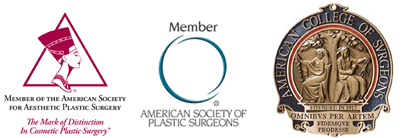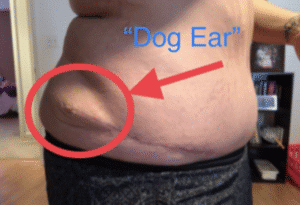“Dog ears” are skin puckers or folds at the end of a tummy tuck incision. They are unwanted skin tissue that can occur as part of a cosmetic abdominoplasty. Dog ears have nothing to do with our friendly pets the dog. It’s a plastic surgery or cosmetic surgery term that is used to describe a problem that can happen after this operation. This educational writing will discuss what they are, how to avoid them surgically, and their treatment. It was written at the request of a patient from Kennett Square, PA.
What are Dog Ears?
During an abdominoplasty, excess skin and fat are removed by a lower abdominal incision. This incision is in approximately the same location as a C-section incision, and it is typically near the top of the pubic area. The incision extends toward the hip area. Its length is determined by how much loose skin you have. Dog ears happen at the ends or the sides of this incision. This medically is called the lateral side. Dog ears are folds or flaps of skin that don’t lie flat. They are puckers at the ends of the incision.
These folds are well defined risks or complications after a tummy tuck. They don’t hurt you. They just aren’t attractive. Other operations can cause poor scars or scars we don’t like. C-section scars often pucker and get indented. Surgery might be necessary to improve this appearance. If you don’t like your C-section scar there are options to dramatically improve it. You can link to another of my educational writings to learn about this.
How do we Surgically Avoid Them?
I perform a large number of tummy tucks each year. It is one of my specialties, and I work meticulously on surgical methods and techniques to give the best results. So, what do I do to minimize or prevent dog ears with a tummy tuck? It’s the last thing I do near the end of every single abdominoplasty operation. I look for any skin flap, loose skin, or pucker. The best way to NOT have a dog ear is to look for it at surgery and treat it right on the operative table before you finish! There are two main ways to avoid them: liposuction or excise them. The first thing is to try and flatten the pucker with liposuction. I try to remove any extra fat so the skin lies flat. If this doesn’t work, I extend the incision a small bit and essentially cut it out. These two methods are critical to surgically avoid dog ears. They have high success and great results, in my opinion and experience.
But despite what I just described, the chance of dog ears will not be zero. I never finish a tummy tuck with any puckers or dog ears. On my surgical table, the rate is ZERO! But surgery and healing are not always fair. With healing and poor skin elasticity, small dog ears can develop. I always thought this was frustrating. I spend time to have NO puckers or flaps at all! But you still can get them. If this happens however, they will be very small. Skin elasticity is poor. It’s why we are doing the abdominoplasty to begin with. This area is the transition from cutting out skin to stopping the cutting. It can unfortunately develop a pucker despite the best of intentions.
Doctors that do not try and focus on this problem area, can develop large dog ears. I believe this is from poor techniques. It won’t happen with my operations. If a plastic surgeon doesn’t focus on their prevention, than large ones can happen. By finishing every operation with NO dog ears, we can prevent the vest majority of people having any problems. Despite this attention to detail, there still is the chance of getting small ones that might need treatment.
How are They Treated?
The surgical treatment is actually very similar to the prevention. However, the first treatment is compression wraps. Swelling and bruising can lead to puckering and unevenness at the ends of the surgical incision. This swelling is common after surgery and is treated with the binder or other compression garments . I have my patients wear the binders tight after the drain removal. (They shouldn’t be worn tight initially until instructed to do so.) Compression garments are extremely important to help healing. They help squeeze out fluid, swelling, and blood. They often will work in flattening out any puckers. They have very high success rates for small areas in my experience.
The binders are also important for the scar itself. As I have reviewed in other educational writings, the pressure from the binder is probably the single most important thing to do after surgery to get the best scar. The pressure helps collagen remodeling and helps the scar flatten and heal well. Burn victims, who have severe scars, will be instructed to wear compression garments to the burn area for one full year or longer. Our tummy tuck scars will also benefit from compression wraps. It’s extremely important. I emphasize the importance of the compression garment after tummy tucks to get the flattest and best surgical incision and scar.
Despite the meticulous techniques to avoid dog ears and despite the emphasis on compression afterwards, some patients will develop this problem. The mainstays of treatment are liposuction or surgical revision. Either procedure can be done under local anesthesia. Sometimes just a bit more liposuction will flatten out the area. Some patients will require surgical revision. This is where a bit more skin is cut out or excised. Either way the recovery is typically easy. Compression is worn afterwards. Most people can return to their jobs and normal activities quickly. Success and satisfaction are typically very high.
Summary:
Dog ears are puckers of skin and fat that can occur at the sides of a tummy tuck incision. Meticulous technique is used at surgery to avoid these puckers. “An ounce of prevention is worth a pound of cure.” By focusing on NOT having them at the completion of the abdominoplasty, the rate of dog ears is very low in my hands. Despite these techniques, some patients will get a dog ear. Treatment options include compression wraps, liposuction, and surgical excision. Treatment tends to be easy and have high success rates.




